 Last additions Last additions |

View of Honmaru (Bizen Maru), main road to Himeji Station, and Nishi-no-MaruJan 20, 2006
|
|

Osakabe Shrine on top floor of Himeji Castle. This shrine was already on the hill before the castle was built. The shrine was moved when the castle was built, but it was brought into the castle after some "curses" occurred.Jan 20, 2006
|
|

Top floor of castle towerJan 20, 2006
|
|

Fifth floorJan 20, 2006
|
|

To top floorJan 20, 2006
|
|

View of HonmaruJan 20, 2006
|
|

Jan 20, 2006
|
|

Jan 20, 2006
|
|

Warrior armor displayed on second floor of Himeji Castle towerJan 20, 2006
|
|

Gun racks called bugukake. 武具掛Jan 20, 2006
|
|

Sign for bugukake weapon racks. Most explanatory signs are also in English.Jan 20, 2006
|
|

Weapon racks called bugukake. 武具掛Jan 20, 2006
|
|

Weapon racks called bugukake. 武具掛Jan 20, 2006
|
|

To second floorJan 20, 2006
|
|

Sword exhibitJan 20, 2006
|
|

Jan 20, 2006
|
|

Jan 20, 2006
|
|

First floorJan 20, 2006
|
|

First flight of stairsJan 20, 2006
|
|

Mizu-no-roku Gate doorJan 20, 2006
|
|

Take off your shoes before entering.Jan 20, 2006
|
|

Inside Mizu-no-roku GateJan 20, 2006
|
|

Mizu-no-go Gate doorJan 20, 2006
|
|

Mizu-no-roku GateJan 20, 2006
|
|

Jan 20, 2006
|
|

Mizu-no-go Gate. 水五門Jan 20, 2006
|
|

Path to castle tower entranceJan 20, 2006
|
|

Castle tower 大天守Jan 20, 2006
|
|

Jan 20, 2006
|
|

Castle tower stone foundationJan 20, 2006
|
|

Castle tower viewed from Bizen Maru (Honmaru) 大天守Jan 20, 2006
|
|

Castle tower viewed from Bizen Maru (Honmaru). 大天守Jan 20, 2006
|
|

"Sama" hole for dropping stones, throwing spears, etc.Jan 20, 2006
|
|

Stone coffins at Bizen Gate. Due to a shortage of stones during the castle's construction, many stone coffins unearthed from the tumulus on the hill of the castle were used in the rock walls. The stone coffins were replaced by real stones during the cDue to a shortage of stones during the castle's construction, many stone coffins unearthed from the tumulus on the hill of the castle were used in the rock walls. The stone coffins were replaced by real stones during the castle restoration in the 1960s.Jan 20, 2006
|
|

Bizen Gate entrance to Honmaru, also called Bizen-maru. Notice the coffin stone on the right of the gate. (Important Cultural Property) 備前門Jan 20, 2006
|
|

Well Turret. The well is 16 meters deep with water 1 meter deep.Jan 20, 2006
|
|

Well Turret sign. The turret is to defend the rear of the castle. It has three rooms, one of which has a 16-meter deep well. 井郭櫓Jan 20, 2006
|
|

Chi-no-mon Gate (after passing through)Jan 20, 2006
|
|

View of castle tower from Chi-no-mon GateJan 20, 2006
|
|

He-no-mon Gate in the distance. As seen from Chi-no-mon Gate.Jan 20, 2006
|
|

One end of To-no-ichi GateJan 20, 2006
|
|

To-no-ichi Gate との一問Jan 20, 2006
|
|

View from He-no-mon GateJan 20, 2006
|
|

Chi-no-mon Gate in the distance. On the left partially hidden is To-no-ichi Gate. ちの門Jan 20, 2006
|
|

He-no-mon Gate への門Jan 20, 2006
|
|

Inside storehouseJan 20, 2006
|
|

Koshi Kuruwa storehouse (Waist Quarter) for salt and rice.Jan 20, 2006
|
|

The family crest of the resident warlords who repaired the castle remain on the roof.Jan 20, 2006
|
|

The family crest of the resident warlords who repaired the castle are displayed. The warlords include Hashiba (later Toyotomi) Hideyoshi, Ikeda Terumasa, Honda Tadamasa, Matsudaira Tadaaki, Matsudaira Naomoto, Sakakibara Tadatsugu, and Sakai Tadazumi.Jan 20, 2006
|
|

Family crest on roof tiles. The family crest of the resident warlords who repaired the castle remain on the roof.Jan 20, 2006
|
|

Inside storehouseJan 20, 2006
|
|

Koshi no Kuruwa storehouse for rice and saltJan 20, 2006
|
|

StorehouseJan 20, 2006
|
|

Castle roof undersideJan 20, 2006
|
|

Inside Ni-no-mon Gate. A bottleneck gate designed so not many enemy soldiers can pass through at one time.Jan 20, 2006
|
|

Ni-no-mon Gate (Important Cultural Asset) にの門Jan 20, 2006
|
|

Path to Ni-no-mon GateJan 20, 2006
|
|

Path to Ha-no-mon Gate はの門Jan 20, 2006
|
|

Ro-no-mon Gate (Important Cultural Asset) ろの門Jan 20, 2006
|
|

I-no-mon Gate (Important Cultural Asset) いの門Jan 20, 2006
|
|

Sangoku Moat in Ni no Maru, 三国堀Jan 20, 2006
|
|

Jan 20, 2006
|
|

Ni no Maru. After passing through Hishi Gate, this is what you see.Jan 20, 2006
|
|

View from the right of Hishi GateJan 20, 2006
|
|

View from the right of Hishi GateJan 20, 2006
|
|

Hishi Gate, Important Cultural Property. Pass though this large gate to proceed to the Ni no Maru compound. 菱門Jan 20, 2006
|
|

Path to Hishi Gate. 菱門Jan 20, 2006
|
|

Castle ticket office and entrance. Admission is 600 yen for adults. Hours are 9:00 a.m. to 4:00 p.m. (September through May) or 9:00 a.m. to 5:00 p.m.(June through August).Jan 20, 2006
|
|

Jan 20, 2006
|
|

Castle tower, a National Treasure. 大天守Jan 20, 2006
|
|

Himeji Castle tower, a National Treasure. 大天守Jan 20, 2006
|
|

Castle tower closeup. 大天守Jan 20, 2006
|
|

Main castle tower (donjon), called Tenshu. 大天守Jan 20, 2006
|
|

Castle view from San no Maru.Jan 20, 2006
|
|

San no Maru cherry trees. The stone marker says that Himeji Castle is one of Japan's 100 Best Cherry Blossom Sites.Jan 20, 2006
|
|

Special Historical Place markerJan 20, 2006
|
|

World Heritage Site marker. 世界遺産 姫路城Jan 20, 2006
|
|

San no Maru. This area is ringed by cherry trees. 三の丸広場Jan 20, 2006
|
|

Otemon Gate, Main gate to castle. Reconstructed in 1937. 大手門Jan 20, 2006
|
|

World Heritage Site marker. 世界遺産 姫路城Jan 20, 2006
|
|

Castle moatJan 20, 2006
|
|

Path to Otemon Gate, the main gate to the castle. 大手門Jan 20, 2006
|
|

Uchibori Inner MoatJan 20, 2006
|
|

Road to Himeji Castle. Otemae Boulevard (Symbol Road). 大手前通りJan 20, 2006
|
|

Road to Himeji Castle. From Himeji Station, the main road leads to the castle which can be seen in the distance.Jan 20, 2006
|
|
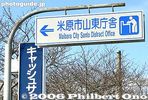
Sign to city hall with misspelled word. "Distract" should be "District."Jan 17, 2006
|
|
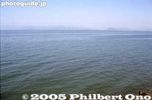
Lake BiwaJan 17, 2006
|
|
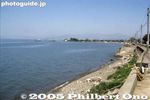
Lake Biwa shoreJan 17, 2006
|
|

Lake Biwa shore. If you leave Maibara Station and head straight for the lake, this is what you will see.Jan 17, 2006
|
|

Tenmangu ShrineJan 16, 2006
|
|

Tenmangu ShrineJan 16, 2006
|
|

Stone for safe childbirthJan 16, 2006
|
|

Jan 16, 2006
|
|

樹下神社Jan 16, 2006
|
|

Jan 16, 2006
|
|

Kaeru frog to wish you a safe return. 東門院Jan 16, 2006
|
|

Dobashi BridgeJan 16, 2006
|
|

Tomon-in temple built by Buddhist Priest Saicho (Dengyo Daishi) to protect his Enryakuji temple on Mt. Hiei from demons from the east. 東門院Jan 16, 2006
|
|

Old Nakasendo Road and Dobashi Bridge. Supposedly, this is the bridge from where Hiroshige drew his print of Moriyama-juku.Jan 16, 2006
|
|

Road marker. Established in 1642, Moriyama-juku was the sixty-seventh of the sixty-nine stations or shukuba post towns on the Nakasendo Road. It is the eighth Nakasendo station in Shiga (following Musa-juku in Omi-Hachiman).Jan 16, 2006
|
|

Marker for the Kabuto-ya innJan 16, 2006
|
|

Rear of road markerJan 16, 2006
|
|

Road marker. Go right for the Nakasendo Road. MAPJan 16, 2006
|
|

Jan 15, 2006
|
|

All fires totally fizzled out.Jan 15, 2006
|
|

Fire truck and hydrant right outside the shrine.Jan 15, 2006
|
|

Withdrawing the burnt-out torchJan 15, 2006
|
|

Shrine worshippersJan 15, 2006
|
|

Snuffing out the last flamesJan 15, 2006
|
|

The giant torches burnt out within 10 minutes.Jan 15, 2006
|
|

Local firemenJan 15, 2006
|
|

You can take home a branch of the torch for family safety.Jan 15, 2006
|
|

Withdrawing the burnt-out torchJan 15, 2006
|
|

Jan 15, 2006
|
|

Jan 15, 2006
|
|

After a few minutes and before it gets unbearably hot, the fire peters out.Jan 15, 2006
|
|

Jan 15, 2006
|
|
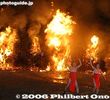
Jan 15, 2006
|
|

Katsube Fire Festival: Men dance in rings in front of the fire. Also see the video at YouTube.Jan 15, 2006
|
|

Jan 15, 2006
|
|

It gets very hot...Jan 15, 2006
|
|

They turned off all the lights and lit the torches all at once! Torch lighting! (たいまつ ほうか 松明奉火)Jan 15, 2006
|
|

Giant torches in Katsube Shrine, Moriyama, Shiga Pref.Jan 15, 2006
|
|

One torch enters the shrine. At around 8 pm, the young men start hauling in the giant torches that were displayed in the neighborhood.Jan 15, 2006
|
|

One of the six torches carried into the shrine.Jan 15, 2006
|
|

A total of 12 torches are then in the shrine.Jan 15, 2006
|
|

The waiting crowd.Jan 15, 2006
|
|

Jan 15, 2006
|
|

At around 8 pm, the three taiko drums return to Katsube Shrine (たいこ みやいり 太鼓宮入り)Jan 15, 2006
|
|

Taiko drum procession. Three taiko drums are carried around the neighborhood.Jan 15, 2006
|
|

Jan 15, 2006
|
|

Jan 15, 2006
|
|

Jan 15, 2006
|
|

Prayer ceremony at Katsube Shrine before they start parading with three taiko drums. 修祓式(しゅっぱつしき)Jan 15, 2006
|
|

Jan 15, 2006
|
|

Taking a sip of sacred sake. They soon get pretty drunk with sacred sake as they walk around the neighborhood beating the taiko drum.Jan 15, 2006
|
|

At 6 pm, half-naked young men wearing loincloths march to the shrine. They are 15-34 years old. 迎えJan 15, 2006
|
|

Katsube Shrine was founded in 649 and originally dedicated to a warrior god by the Mononobe clan.Jan 15, 2006
|
|

Rear view of torches.Jan 15, 2006
|
|
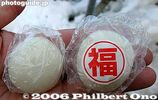
Good luck mochi rice cakes. I caught two of them. The kanji character is "fuku" meaning good luck.Jan 13, 2006
|
|

Shrine maidens ready to toss the mochi at Hokoku Shrine. Another highlight of Toka Ebisu.Jan 13, 2006
|
|

Hokoku Shrine, Nagahama, ShigaJan 13, 2006
|
|

Inside the shrineJan 13, 2006
|
|

On Jan. 11 they burn the old New Year's decorations.Jan 13, 2006
|
|

Jan 13, 2006
|
|

Old New Year's decorations to be burnedJan 13, 2006
|
|

Burning old New Year's decorations, Hokoku Jinja, Nagahama, Shiga Pref.Jan 13, 2006
|
|

Burning of old New Year's decorations in mid-JanuaryJan 13, 2006
|
|

Jan 13, 2006
|
|

Jan 13, 2006
|
|

Jan 13, 2006
|
|

Ebisu is one of the seven gods of good fortune. MAPJan 13, 2006
|
|

Used New Year's decorationsJan 10, 2006
|
|

Karuta Festival. The narrator (standing) recites one of the poems and the contestants must search for and claim the card written with the poem.Jan 10, 2006
|
|

Karuta cards with verses from famous poemsJan 10, 2006
|
|

The Shamusho Shrine office I (社務所I) serves as the Karuta Matsuri tournament venue.Jan 10, 2006
|
|

Jan 10, 2006
|
|

Karuta Festival posterJan 10, 2006
|
|

Jan 10, 2006
|
|

Jan 10, 2006
|
|

Sotokairo corridor (外廻廊), Jinpu-Juyosho shop selling souvenirs (神符授与所), and Rōmon Gate (楼門)Jan 10, 2006
|
|

Jan 10, 2006
|
|

Gift shop and clock museum in background. 時計博物館Jan 10, 2006
|
|

Sun dial. Another one in the background as well. Hidokei I (日時計1: Sundial I)Jan 10, 2006
|
|

CorridorJan 10, 2006
|
|

Inner side of Omi Jingu Shrine's Rōmon Gate (楼門).Jan 10, 2006
|
|

Naihaiden HallJan 10, 2006
|
|

Naihaiden Hall (Inner Haiden 内拝殿)Jan 10, 2006
|
|

Gehaiden Hall (Outer Haiden 外拝殿)Jan 10, 2006
|
|

Omi Jingu Shrine's Rōmon Gate (楼門)Jan 10, 2006
|
|

PoetryJan 10, 2006
|
|

Omi Jingu Shrine's Rōmon Gate (楼門)Jan 10, 2006
|
|

Steps to Rōmon Gate, the shrine's most outstanding structure. (楼門)Jan 10, 2006
|
|

Built in 1940, Omi Jingu Shrine is dedicated to Emperor Tenji who moved the capital to Otsu in 667 at the location of this shrine. Otsu was therefore once the capital of Japan. MAPJan 10, 2006
|
|

Path to shrine. Omi Shrine is a short walk from Omi Jingu-mae Station on the Keihan Ishiyama-Sakamoto Line.Jan 10, 2006
|
|

Inn sign. The 200-year-old Nakamura-ya inn burned down on Dec. 10, 2010.Jan 10, 2006
|
|

Musa-juku 武佐宿Jan 10, 2006
|
|

Musa's HonjinJan 10, 2006
|
|

Site of Musa-juku's Honjin, the town's exclusive lodging for VIPs to stopover or rest. Only the gate remains.Jan 10, 2006
|
|

Honjin signJan 10, 2006
|
|

Hatago inn called Nakamura-ya, this was the only remaining inn in Musa-juku. Unfortunately, this inn was destroyed by an early morning fire on Dec. 10, 2010. No one was hurt. The inn owners were sleeping on the 1st floor and they escaped.Jan 10, 2006
|
|
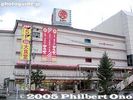
Dept. storeDec 17, 2005
|
|
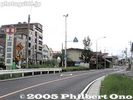
Kami Suwa Onsen (Spa)Dec 17, 2005
|
|

Onbashira rope on train platformDec 17, 2005
|
|
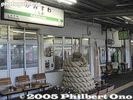
Onbashira rope on train platformDec 17, 2005
|
|
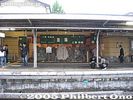
Kami-Suwa Station platform with hot spring foot bathDec 17, 2005
|
|

JR Kami-Suwa StationDec 17, 2005
|
|

Hot spring foot bathThat's not me in the picture.Dec 17, 2005
|
|
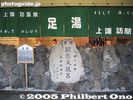
Hot spring foot bathDec 17, 2005
|
|
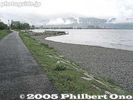
Dec 17, 2005
|
|
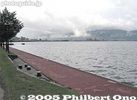
Dec 17, 2005
|
|
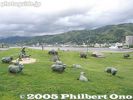
Sheep sculptureDec 17, 2005
|
|

Hot spring foot bathDec 17, 2005
|
|

Hot spring foot bath (free)Dec 17, 2005
|
|
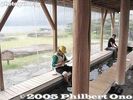
Hot spring foot bathThe place was covered due to rain.Dec 17, 2005
|
|

Hot spring foot bathDec 17, 2005
|
|

Dec 17, 2005
|
|

Dec 17, 2005
|
|

Dec 17, 2005
|
|

Dec 17, 2005
|
|
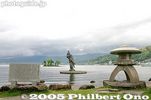
Dec 17, 2005
|
|

Dec 17, 2005
|
|

Dec 17, 2005
|
|

Dec 17, 2005
|
|

Boat cruisesDec 17, 2005
|
|

View from cycling roadDec 17, 2005
|
|

Net fishingDec 17, 2005
|
|

Dec 17, 2005
|
|

Lake SuwaYou can rent a bicycle at Kami-Suwa Station and ride along the lake shore.Dec 17, 2005
|
|

Dec 17, 2005
|
|

This birch tree is a Natural MonumentDec 17, 2005
|
|
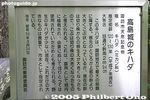
Birch tree plaqueDec 17, 2005
|
|

Dec 17, 2005
|
|

Dec 17, 2005
|
|

Dec 17, 2005
|
|

GardenDec 17, 2005
|
|

Dec 17, 2005
|
|

Dec 17, 2005
|
|

Dec 17, 2005
|
|

View from castle towerDec 17, 2005
|
|

Dec 17, 2005
|
|

View of moat from castle towerDec 17, 2005
|
|

View from castle towerDec 17, 2005
|
|

View of garden from castle towerDec 17, 2005
|
|

Stairs to castle towerDec 17, 2005
|
|

Inside castle towerDec 17, 2005
|
|

Inside castle towerDec 17, 2005
|
|

View from castle towerDec 17, 2005
|
|

Dec 17, 2005
|
|

Dec 17, 2005
|
|

Dec 17, 2005
|
|
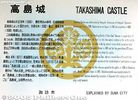
About the castleDec 17, 2005
|
|

Dec 17, 2005
|
|

Dec 17, 2005
|
|
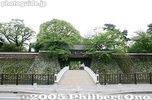
Bridge to castle parkDec 17, 2005
|
|

Takashima Castle 高島城Dec 17, 2005
|
|

Dec 17, 2005
|
|

Castle towerDec 17, 2005
|
|

Takashima CastleDec 17, 2005
|
|

Dec 17, 2005
|
|
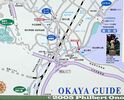
Okaya mapDec 17, 2005
|
|

JR Okaya Station. There is no tourist info office here.Small station, but close to Lake Suwa.Dec 17, 2005
|
|

Statue of KATAKURA KanetaroHe and his company planted the azaleas in 1935.
片倉兼太郎Dec 17, 2005
|
|

Dec 17, 2005
|
|

Dec 17, 2005
|
|

Dec 17, 2005
|
|

Dec 17, 2005
|
|

Path to more azaleas as far as the eye can see.Dec 17, 2005
|
|

Dec 17, 2005
|
|

Dec 17, 2005
|
|

Dec 17, 2005
|
|

Dec 17, 2005
|
|
| 71466 files on 284 page(s) |
 |
 |
273 |  |
 |
|